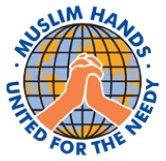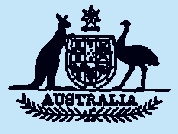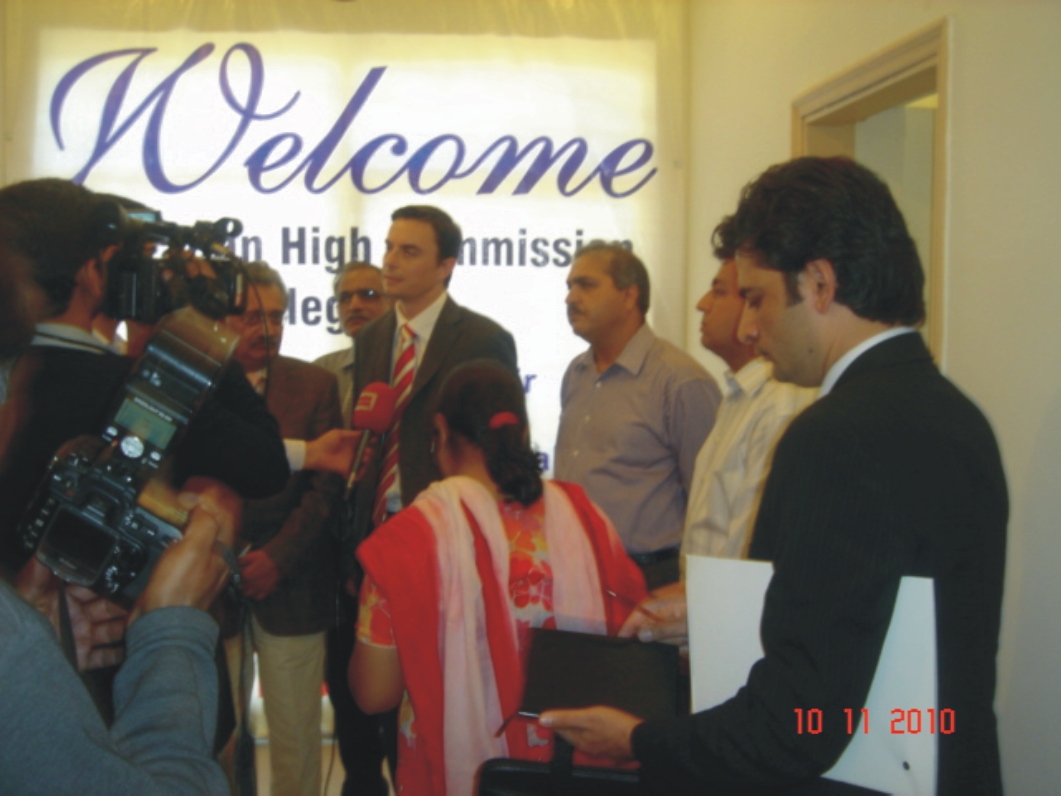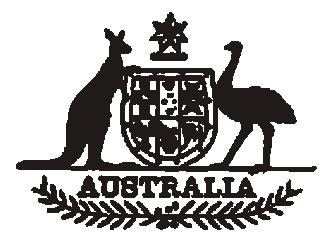Newsletter dec 2010





Life Saving Organization
Pakistan Myasthenic Welfare Organisation
On behalf of the Muslim Aid Khalid Mehmood Zia Founder
PMWO is handing over Platelets Kits to Chief Minister Punjab
for the treatment of Dengue Fever Patients.
"At this occasion Chief Minister Punjab Mian Muhammad Shahbaz Sharif
appreciate the great contribution of Muslim Aid for Dengue Fever patients.
The Plasmapheresis & Platelets Center of Muslim Aid & PMWO in
Jinnah Hospital Lahore has been doing tremendous clinical work for
Dengue Fever patients by providing free Platelets to critical patients
with Dengue Fever & Cancer. Many precious lives saved with the donation
of Muslim Aid"
Contribution of Australian High Commission . pg 2
PMWO & its Current Activities . pg 3
A Guide to Myasthenia Gravis & its Treatment . pg 4
A Layman Guide to GBS/CIDP? . pg 5
MG and Pregnancy . pg 6
Your generosity
brings us closer to a
New Drug (Monarsen EN101) for MG Patients . pg 7
world without MG, GBS/CIDP
Dengue Fever in Pakistan . pg 8



Contribution of Australian High CommissionIslamabad for FREE treatment of poor patients
Treatment of Mr. Peter Bartlett, First Secretary Political Australian High
Commission Islamabad is sharing his views to media during his
poor patients. visit to PMWO Plasmapheresis Center at Allama Iqbal Medical
College/Jinnah Hospital Lahore.
Australian High Commission Islamabad has donated 01 million rupees to PMWO under the Direct Aid Programme
PATIENTS TREATED BY MUSLIM AID & PMWO PLASMAPHERESIS & PLATELETS CENTER
AT PIMS, ISLAMABAD & JINNAH HOSPITAL, LAHORE IN 2010
(DAP) for the FREE provision of
an advance health care facility of
Dengue Fever
Plasmapheresis for the rapid
clinical management of poor &
indigent patients reported from
the most vulnerable population of the Punjab through the
Total Number of Patients = 1983
Total Number of Plasmapheresis = 2296
PMWO Plasmapheresis Center
Total Number of Platelets = 1409
PMWO & its activitiesPakistan Myasthenic Welfare Organization (PMWO) is a registered voluntary health agency with charitable status for the diagnosis and treatment of patients with Neurological disorders (MG, GBS, CIDP and Polyneuropathy). PMWO is the only health organization of its nature in Pakistan, which has organized a comprehensive treatment of MG and GBS and dedicated to provide free treatment to poor & indigent patients including Medicines, Plasmapheresis and Thymectomy. PMWO was established in 1990.
Please help us to fight
Myasthenia Gravis, GBS/CIDP,
Our vision is that every person of MG, GBS, CIDP or variants has
Polyneuropathy, Dengue Fever &
convenient access to early diagnosis and affordable treatments and
Cancer patients.
dependable support services.
Make your donations in the name of
PMWO for the better care of ailinghumanity.
PMWO striving for the welfare and care of most vulnerable people of the society suffering from Neurological disorders and
Bank Account of PMWO:
after treatment such people should achieve fulfillment in all
Allied Bank of Pakistan
aspects of their lives.
Blue Area Branch IslamabadAccount # 1283-8
2. To improve the quality of life of individuals and families
worldwide affected by MG, GBS, CIDP and variants regardless of religion, ethnicity, nationality, gender or age.
Islamic Bank of Britain Coventry Road Birmingham (U.K.)
3. To find the cure of MG, GBS and CIDP through education and
Account No. 01122801
research with international cooperation.
Sort Code: 30-00-83
Life Saving Projects of PMWO
Plasmpaheresis Centre of PMWO at Pakistan Institute of Medical
Sciences (PIMS) Islamabad for rapid clinical management of patients
with Neurological disorders referred from AJK, Punjab, Khyber Pakhtunkhwa & Northern Areas.
v Single Donor Platelets Service for Cancer and Dengue Fever
Patients by the PMWO Plasmapheresis Center PIMS.
v Myasthenic Drug Bank Project of PMWO for Poor Patients.
PMWO Plasmapheresis Excellence Centre at Allama Iqbal Medical College / Jinnah Hospital, Lahore.
v Mobile Plasmapheresis Service of PMWO to all teaching hospitals
from Peshawar to Lahore.
v GBS Child Rehabilitation Center.
v Counseling and Rehabilitation Program for young MG Patients.
v Rehabilitation and support Program for Myasthenic Mothers.
A Guide to MG & its Treatment
Myasthenia Gravis (MG)
Myasthenia Gravis comes from the
There are many disorders that cause
Greek and Latin words meaning
weakness. In addition to a complete
grave muscular weakness. The most
medical and neurological evaluation,
common form of MG is a chronic
a number of tests may be used to
autoimmune neuromuscular
establish a diagnosis of MG. A blood
disorder that is characterized by
test for the abnormal antibodies can
fluctuating weakness of the
be performed to see if they are
voluntary muscle groups. The
present. Electromyography (EMG)
prevalence of MG in the Pakistan is
studies can provide support for the
estimated to be about 15/100,000
diagnosis of MG when characteristic
population. However, MG is
patterns are present. The
probably under diagnosed and the
Edrophonium Chloride (Tensilon)
prevalence may be higher.
test is performed by injecting this chemical into a vein. Improvement
Clinical Features &
Thymectomy (surgical removal of
of strength, immediately after the
the thymus gland) is another
injection, provides strong support
MG occurs in all races, both genders
treatment used in some patients.
for the diagnosis of MG. Sometimes
and at any age. MG is not directly
The thymus gland lies behind the
all of these tests are negative or
inherited nor is it contagious. It does
breastbone and is an important part
equivocal in someone whose story
occasionally occur in more than one
of the immune system. When there
and examination still seem to point
member of the same family. MG may
is a tumor of the thymus gland (in
to a diagnosis of MG. The positive
affect any muscle that is under
10-15%), it is always removed
clinical findings should probably
voluntary control. Certain muscles
because of the risk of malignancy.
take precedence over negative
are more frequently involved and
Thymectomy frequently lessens the
confirmatory tests.
these include the ones that control
severity of the MG weakness after
eye movements, eyelids, chewing,
some months. In some people, the
swallowing, coughing and facial
weakness may completely disappear.
expression. Muscles that control
There is no known cure for MG, but
This is called a remission. The
breathing and movements of the
there are effective treatments that
degree to which the thymectomy
arms and legs may also be affected.
allow many, but not all people with
helps varies with each patient.
Weakness of the muscles needed for
MG, to lead full lives. Common
Plasma pheresis or plasma exchange
breathing may cause shortness of
treatments include medications,
may be useful in the treatment of
breath, difficulty taking a deep
thymectomy and plasmapheresis.
MG also. This procedure removes
breath and coughing.
Spontaneous improvement, even
the abnormal antibodies from the plasma of the blood. The
remission, may occur without
The muscle weakness of MG
improvement in muscle strength
specific therapy. Medications are
increases with continued activity and
may be striking but is usually short-
most frequently used in treatment.
improves after periods of rest. The
lived since production of the
Anticholinesterase agents (e.g.,
muscles involved may vary greatly
abnormal antibodies continues.
Mestinon) allow acetylcholine to
from one patient to the next.
When plasma pheresis is used, it
remain at the neuromuscular
Weakness may be limited to the
may require repeated exchanges.
junction longer than usual so that
muscles controlling eye movements
Plasma exchange may be especially
more receptor sites can be activated.
and the eyelids. This form of
useful during severe MG weakness
Corticosteroids (e.g., prednisone)
myasthenia is referred to as Ocular
or prior to surgery. Treatment
and immunosuppressant agents
MG. In its severest form, MG
decisions are based on knowledge of
(e.g., Imuran) may be used to
involves many of the voluntary
the natural history of MG in each
suppress the abnormal action of the
muscles of the body including those
patient and the predicted response
immune system that occurs in MG.
needed for breathing. The degree
to a specific form of therapy.
and distribution of muscle weakness
Intravenous immunoglobulins
Treatment goals are individualized
for many patients falls in between
(IVIg) are sometimes used to affect
according to the severity of the MG
these two extremes. When the
the function or production of the
weakness, the patient's age and sex,
weakness is severe and involves
abnormal antibodies also.
and the degree of impairment.
A Layman Guide to GBS/CIDP Diagnosis & Treatment
In Pakistan GBS patients are
What is GBS?
being reported from the poor
Guillain-Barre Syndrome (GBS) is a disorder in which the body's
population. Day by day due to the
immune system attacks the nerves. It is rare, occurring in only one or
poor living conditions and
two people per 100,000. It can develop rapidly, beginning with
environmental pollution is
weakness and abnormal sensations in the extremities and often
creating the alarming situation of
progressing to paralyze the body within days. In many cases, the
GBS patients in Pakistan.
paralysis extends to the arms, face, and even the breathing muscles - forcing patients to rely on ventilator. But in most cases, GBS is temporary, with more that 85% of patients making a recovery.
How are GBS & CIDP
What is CIDP?
CIDP is also caused by the body's immune system attacking the nerves. As with GBS, the major symptom in CIDP is ascending weakness, but it
For patients with GBS, treatment
occurs slowly over at least 2 months and is often accompanied by
concentrates on supporting the patient
abnormal sensations, such as tingling and numbness. These symptoms
during paralysis, reducing the severity
are usually not as severe as in GBS, but they can often recur. However, CIDP does tend to respond very well to treatment, with around 80% of
of the condition, and speeding recovery.
new cases showing a dramatic response to therapy.
Newly diagnosed patients are usuallyhospitalized and placed in an intensive
How do GBS & CIDP Develop?
care unit, where body functions can be
GBS and CIDP damage the nerves that extend from the spinal cord and
monitored and adequate support given
run throughout the body, transmitting electrical signals from the brain to enable movement, sensation, and the regulation of body functions,
during paralysis. Patients are then
such as breathing and the heartbeat. In healthy people, many of these
given treatment to help combat the
nerves are covered by a protective sheath, just as household electrical
condition. on type of treatment, plasma
wires are covered by insulation. But in GBS and CIDP, the body's
exchange, aims to clean the blood of the
immune system attacks the protective sheath causing damage that
antibodies that attack the nerves.
slows done or stops the nerves from conducting the brain's signals, which can lead to weakness, loss of sensation, and even paralysis.
Another treatment, high-dose
Nobody knows for sure why the immune system attacks the nerves in
intravenous immunoglobulin therapy,
CIDP. But in the case of GBS, various events may act as trigger. Many
is thought to block the harmful
cases occur shortly after a viral or bacterial infection, such as the
antibodies. Both of these treatments are
common cold, a sore throat, or diarrhea. Cases have also developed
equally effective and can dramatically
fallowing surgery or immunizations. Normally, the body's immune system can recognize and attack microbes that invade the body. Current
speed the patient toward recovery.
theory on GBS, however, suggests that the body is infected by a microbe that somehow resembles the nerves. So when the immune system
Patients with CIDP tend not to need
targets the intruding infection, the nerves are attacked inadvertently.
intensive care. They may also benefitfrom treatment with steroids or
HOW are GBS & CIDP Diagnoses?
immunosuppressive drugs that help
Dignosis of GBS and CIDP is often based on the patient's symptoms and a physical exam. The onset of muscle weakness is usually distinctive-
stop the from attacking the nerves.
ascending on both sides of the body, rather that affecting one side as in a
Such treatments are no suited to every
stroke. In the case of GBS, the progression of weakness is also rapid;
patient because they reduce the body's
whereas with CIDP, the progression of weakness takes much longer and
ability to fight infection. But in cases
is generally less severe-rarely extending to affect the breathing or facial
where these treatments are not an
muscles. Both conditions are associated with loss of reflexes, such as the
option, patients can often respond well
knee jerk, and diagnosis can be confirmed by measuring protein levels in the spinal fluid and through the testing of nerve and muscle function.
to the same treatments used for GBS.
MG and Pregnancy
Things to Consider for Myasthenic Mother!
Myasthenia Gravis (MG) is common in women of child-bearing age. The effect
of MG on women and their newborns should be carefully considered and
monitored during and following pregnancy. Below are some questions that
women often ask in this situation.
Will my baby be healthy?
Overall the risk of birth defects is not increased for women with MG and is
comparable to pregnancies of women without MG. A rare birth defect that has
been linked to MG is arthrogryposis, which refers to muscle weakness and
joint deformities that are present at birth. Women who have large amounts of a
specific type of antibody that targets the infantile form of the acetylcholine
receptor are more likely to deliver babies with arthrogryposis. The fortunate
feature is that women who deliver babies with arthrogryposis usually do not
have clinical MG. The subset of antibodies that cause arthrogryposis, do not
cause symptoms in adults. Consequently, women who have MG are not likely
to have babies with arthrogryposis. Severe arthrogryposis can be recognized
by ultrasound prior to delivery. One health concern that women with MG and
their doctors must consider is transient neonatal MG (TNMG). TNMG occurs
when MG antibodies are transferred from the mother to the baby and can be
effectively addressed if anticipated. The baby will need treatment, perhaps for
several days to a week, until the MG antibodies from the mother have been
removed from the baby or spontaneously broken down. Babies who have had
TNMG have grown to be normal children.
How will my MG treatment complicate my ability to get pregnant?
Women need to consider several issues and have extensive discussion with their physicians and other women who
have been pregnant before they attempt pregnancy. As pregnancy advances, women frequently feel fatigued.
Fatigue can be more prominent in women with MG. Treatment with anticholinesterase medications, such as
pyridostigmine (mestinon®), does not affect the ability of an individual to become pregnant nor is it known to
appreciably complicate a woman's ability to carry a pregnancy. There is slight risk of anticholinesterase medication
triggering or enhancing uterine contractions. Many people with MG are treated with medications that alter the
immune system, immunosuppressive agents. Immunosuppressive agents include glucocorticoids, such as
prednisone, azathiaprine, mofetil mofetate (CellCept®), cyclosporine and other agents. It is essential if you are
taking a medication or treatment to alter your immune system that you discuss the risks associated with getting
pregnant when using that treatment. In general glucocorticoids can be continued during pregnancy.
How will pregnancy affect my MG?
About a third of women with MG will have a flare of their MG during the first trimester of pregnancy. In general, MG
symptoms, with the exception of general fatigue, tend to decline during the second and third trimesters of
pregnancy. As pregnancy advances, breathing during sleep can be compromised in any pregnant woman. Because
disorders of sleep, particularly sleep apnea, are often under-recognized in people who have MG, women
contemplating pregnancy should discuss with their caregivers whether they should have a sleep study to evaluate
their breathing when asleep. The usual treatment for sleep apnea, continuous positive airway pressure (CPAP), does
not complicate pregnancy.
Reference
Carlayne E. Jackson The effect of myasthenia gravis on pregnancy and the newborn. Neurology 2003; 61; 1459-1460 [The online
version of this article, along with updated information and services, is located on the World Wide Web at: http://www.neurology.
org/cgi/content/full/61/10/1459] See the MGFA website for the full article on Pregnancy and MG or contact National at 800-541-5454
for a copy of the brochure.
(Courtesy MGFA fall 2010)
New Drug (Monarsen EN101) for Myasthenia Gravis Patients
This brief text addresses Monarsen (also known as EN101). Monarsen is an orally available preparation of nucleic acids (DNA and RNA are made of long strings of nucleic acids) that is designed to interfere with the production of acetylcholine esterase (AChE). This is a novel approach to inhibiting AChE. Mestinon is a medication that is commonly used by people with MG and it acts by inhibiting AChE. Monarsen would take longer to act then Mestinon, but could be taken once a day. Consequently, Monarsen has the potential to be an alternative to Mestinon for people with MG. An additional possible benefit of Monarsen is that it may act to suppress the immune system through its action on a form of AChE that may modulate the action of white cells. Monarsen was developed by basic researchers in Israel. These researchers sold the international production rights for Monarsen to an Israeli company, Ester. The Israeli Company then sold the rights to a British company, Amarin Corp (UK). Amarin has chosen not to continue with the development of Monarsen. Specifically, Amarin is not planning to pursue with phase II or phase III clinical trials of Monarsen. As the rights to Monarsen are owned by a private company, researchers are not able to independently study this preparation. It is MGFA policy not to invest money in private companies, such as Amarin. The Medical/Scientific Advisory Board (M/SAB) of MGFA has
Young female patients
communicated with a researcher in the United Kingdom who is trying to
under Plasmapheresis
negotiate with Amarin to be able to use Monarsen. To date, Amarin has
treatment at PMWO Center
not been willing to allow others to use Monarsen in research studies nor
have they moved Monarsen through the process of getting this preparation approved for clinical use with patients. The M/SAB will continue to explore new strategies to improve the lives of people with MG and to pursue research on treatment for MG. Unfortunately, the M/SAB and other researchers are currently blocked from studying Monarsen.
(Courtesy MGFA fall 2010)
Source: http://www.pmwo.org.pk/files/NewsLetter%20Dec%202010.pdf
Braz J Cardiovasc Surg 2016;31(2):106-14 Clopidogrel use After Myocardial Revascularization: Prevalence, Predictors, and One-Year Survival Rate Paulo Roberto L. Prates1,2, MD; Judson B. Williams3,4, MD; Rajendra H. Mehta4,5, MD, MSc; Susanna R. Stevens5, MSc; Laine Thomas5, PhD; Peter K. Smith3, MD; L. Kristin Newby4,5, MD; Renato A. K. Kalil1,2, MD, PhD; John H. Alexander4,5, MD, MHS; Renato D. Lopes4,5, MD, PhD
YEAR REPORT 2008 DEPARTMENT OF ENDOCRINOLOGY INTERNAL MEDICINE University Medical Center Groningen Postal address Visitors address 9700 RB Groningen 9713 GZ Groningen http://www.umcg.net Year Report 2008 – Dept. of Endocrinology, UMCG & University of Groningen, The Netherlands 1. Personnel . 3









